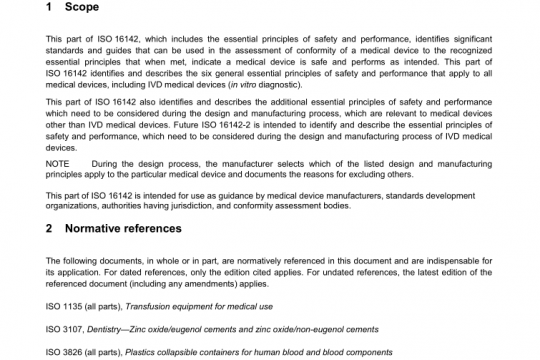AAMI HE74 pdf free download
AAMI HE74 pdf free download.Human factors design process for medical devices.
4 Overview of the HFE process Regardless of whether one is designing a revolutionary new product or making minor modifications to an existing product, the associated HFE process will invariably include several specific HFE elements or steps. Figure 1 depicts the HFE aspects of medical device design as a cycle of steps. This does not imply that every design effort must follow a rigid prescription of development activities. On the contrary, the specific HFE activities at each step in the cycle (and the associated time, effort, and expense required) will vary with each development effort.For each step in the cycle, the HFE team must use evidence, judgment, and experience to determine the appropriate HFE activities and effort. Thus, a fundamental goal of this document is to provide guidance on how to make decisions about the nature and magnitude of HFE activities. The same HFE tools and techniques may be successfully used at several different steps in the HFE cycle. For example, an analysis of the tasks a user performs when interacting with a device (i.e., task analysis) may be equally appropriate during early conceptualization of a new device, when developing specific device design criteria and requirements, and when evaluating a fully functional prototype. However, the type of task analysis employed and the method in which it is performed will likely vary to fit the specific goals of the HFE process at each of these steps.People who are familiar with systems engineering will appreciate the similarity of the depicted cyclical HFE process with other types of process or product development cycles. A fundamental attribute is that, as a product evolves throughout its life span, it will go through many such cycles. With respect to medical devices, particularly when one considers not only HFE activities but also other risk management and design control processes, every step in the cycle must be addressed at least once in any device development process. Additionally, the HFE cycle depicted in Figure 1 emphasizes the iterative nature of the development process. Not only do the outcomes (or outputs) of one step feed (i.e., provide input to) the next step, but also, invariably, the output of some steps feeds back to prior steps. For example, during device evaluation, issues raised by design verification activities (i.e., ascertaining whether device design meets previously established design requirements) frequently lead to design changes. Similarly, issues raised during design validation activities (i.e., ascertaining whether the device adequately addresses established user needs) may precipitate subsequent modifications in design requirements or even in device conceptualization. The description of the HFE process as a cycle of steps may give the misleading impression that user interface development is always a serial process. In fact, many of these activities commonly occur in parallel. Interaction between steps occurs frequently, rapidly, and often seamlessly. For example, in medical software design, an HFE practitioner may accomplish elements of design criteria and requirement development (e.g., usability goals), device design (e.g., rapid prototyping), and design verification (e.g., usability testing) concurrently.AAMI HE74 pdf download.
Other IEC Standards
-

ANSI AAMI ISO 16142-1 pdf free download – non-IVD medical devices and guidance on the selection of standards
AAMI standards list DOWNLOAD -

ANSI AAMI ISO 16142-2 pdf free download – General essential principles and additional specifc essential principles
AAMI standards list DOWNLOAD


